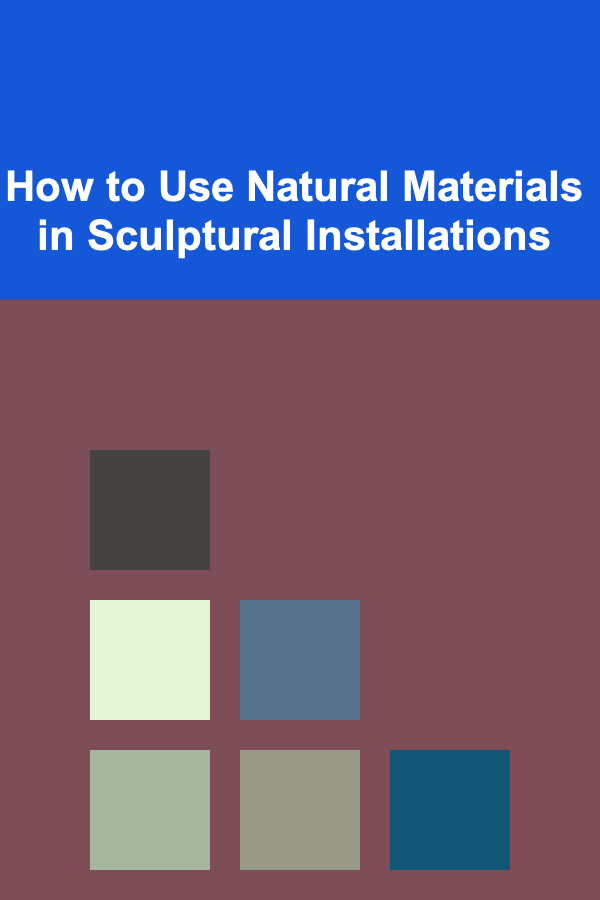
How to Use Natural Materials in Sculptural Installations
ebook include PDF & Audio bundle (Micro Guide)
$12.99$10.99
Limited Time Offer! Order within the next:

Sculptural installations have long been a powerful medium for artists to engage audiences with three-dimensional forms that interact with space, light, and environment. The choice of materials plays a crucial role in shaping the meaning, experience, and impact of these artworks. In recent decades, there has been a marked resurgence of interest in natural materials---wood, stone, clay, fibers, plants, earth, and even ephemeral organic matter---as fundamental components of sculptural practice. This return to nature is driven by ecological awareness, sustainability concerns, a desire for sensory authenticity, and a quest for reconnecting with the environment.
Using natural materials in sculptural installations opens up a rich vocabulary of textures, forms, processes, and symbolism. It offers opportunities to explore impermanence, transformation, and the intimate relationships between human culture and the natural world. However, working with natural materials also presents specific challenges---technical, conceptual, and logistical---that require careful consideration.
This essay will explore the multifaceted ways artists and creators can use natural materials in sculptural installations, discussing the properties and potentials of various materials, strategies for integrating them meaningfully, technical and conservation considerations, and the broader cultural and environmental implications of such work. By the end, readers will gain a nuanced understanding of how natural materials enrich sculptural installations, contributing to a dynamic dialogue between art, nature, and society.
Understanding the Appeal of Natural Materials in Sculpture
Natural materials have a unique tactile and visual presence that synthetic or industrial materials rarely replicate. They carry inherent stories, histories, and cultural associations. Unlike manufactured materials, natural elements often bear marks of growth, decay, weathering, and seasonal cycles---qualities that can imbue sculptures with layers of meaning and evoke emotional responses tied to time, place, and life cycles.
Artists drawn to natural materials often cite several motivations:
- Sustainability: Natural materials are often renewable, biodegradable, and sourced locally, reducing environmental impact.
- Authenticity and Sensory Richness: The textures, colors, and smells of natural elements create immersive experiences that engage multiple senses.
- Conceptual Resonance: Natural materials symbolize themes such as life, death, growth, decay, resilience, and human interconnectedness with nature.
- Historical and Cultural Continuity: Many indigenous and traditional arts use natural materials, offering a lineage and cultural depth.
Yet, natural materials also challenge the artist to work with impermanence and unpredictability---qualities that some embrace as central to the artwork's meaning, while others seek to mitigate through preservation techniques.
Categories of Natural Materials in Sculptural Installations
1. Wood
Wood is one of the oldest and most versatile materials in sculpture. It ranges from rough bark and driftwood to finely carved and polished hardwoods. Wood offers warmth, structural integrity, and organic variability.
- Properties: Wood is lightweight yet strong, carvable, and adaptable to various techniques (carving, joining, bending).
- Aesthetic Qualities: Grain patterns, knots, color variations, and texture provide visual interest.
- Sources: Fallen branches, reclaimed timber, sustainably harvested wood.
- Applications: Freestanding sculptures, large installations, frameworks, interactive elements.
Example: Artist Andy Goldsworthy often uses wood in site-specific sculptures, carefully balancing natural forms and human intervention.
2. Stone
Stone conveys permanence, solidity, and timelessness. Marble, granite, limestone, sandstone, and other natural stones provide a diverse palette of textures and colors.
- Properties: Hardness varies; some stones are amenable to carving and polishing, others better suited for stacking or assembly.
- Symbolism: Stone often signifies endurance, monumentality, or connection to the earth.
- Sources: Local quarries, river stones, beach pebbles.
- Applications: Carved sculptures, aggregate installations, ground-based formations.
Example: Richard Long's stone arrangements create minimal, meditative works that emphasize material and place.
3. Clay and Earth
Earth and clay connect sculpture to the ground and the elemental processes of nature.
- Properties: Malleable when wet, brittle when dry, and can be fired or left unfired.
- Techniques: Modeling, coiling, slab-building, pit-firing.
- Symbolism: Clay evokes creation myths, transformation, and the primal matter of life.
- Applications: Earthen installations, terra cotta forms, land art.
Example: Contemporary land artists often sculpt and shape earth on a grand scale, sometimes inviting natural erosion to complete the process.
4. Plant Materials (Leaves, Branches, Fibers, Flowers)
Plant materials introduce color, delicacy, ephemerality, and biological life cycles into sculpture.
- Properties: Lightweight, flexible, often fragile.
- Symbolism: Life, growth, renewal, and decay.
- Applications: Weaving, assemblage, garlands, living sculptures.
Example: El Anatsui's work uses natural fibers and discarded materials to create monumental textile-like installations.
5. Natural Fibers and Textiles
Materials such as wool, cotton, hemp, jute, flax, and silk link sculpture to traditional craft techniques and tactile softness.
- Properties: Flexible, strong, biodegradable.
- Applications: Wrapping, binding, weaving, suspended installations.
Example: Sheila Hicks explores fibers as sculptural media with complex textures and colors.
6. Other Organic Materials (Bones, Shells, Seeds, Feathers)
These materials introduce symbolism related to life cycles, ritual, and memory.
- Properties: Varied durability, distinct textures.
- Applications: Assemblage, mosaic, symbolic ornamentation.
Integrating Natural Materials: Conceptual and Practical Strategies
Conceptual Considerations
- Site-Specificity: Natural materials often respond to or reflect the site where the installation is placed. Artists can select materials native to the location, creating dialogues between the work and the landscape.
- Temporal Dimensions: Artists can explore ephemerality---allowing natural processes like decay, growth, or weathering to become part of the artwork's life cycle.
- Interaction: Sculptural installations with natural materials often invite tactile engagement, smell, and sound, deepening viewer interaction.
- Cultural References: Use of natural materials can invoke indigenous or local cultural traditions, creating layers of meaning.
- Ecological Message: Highlighting environmental issues or celebrating nature through responsible sourcing and sustainable practices.
Practical Strategies
- Material Sourcing: Ethical and sustainable collection is essential. Harvesting should minimize ecological disruption.
- Preparation: Cleaning, drying, or treating materials to prevent decay or insect infestation.
- Construction Techniques: Joining natural elements with minimal harm (e.g., lashing, pegging, natural adhesives).
- Structural Stability: Reinforcing materials discreetly, combining natural materials with hidden metal or synthetic supports when needed.
- Surface Treatments: Applying natural oils, waxes, or biodegradable coatings to enhance durability without compromising integrity.
Technical Challenges and Conservation
Natural materials bring unique challenges:
- Decay and Deterioration: Wood rots, fibers mold, earth erodes. Artists must decide whether to accept or delay these processes.
- Environmental Sensitivity: Exposure to humidity, sunlight, temperature changes affects stability.
- Pests: Insects and microorganisms can damage organic materials.
- Maintenance: Regular upkeep or conservation may be necessary, especially for public installations.
Conservation approaches include:
- Using stabilizers like natural resins.
- Designing installations to be replaceable or biodegradable.
- Creating documentation (photography, 3D scanning) to preserve the artwork's form beyond its physical lifespan.
Case Studies of Natural Material Sculptural Installations
Andy Goldsworthy: Ephemeral Nature Sculptures
Goldsworthy is renowned for using leaves, ice, stones, and wood in site-specific installations. His work embraces transience---many sculptures exist only briefly before returning to nature. His careful arrangement of materials highlights natural patterns and cycles, inviting reflection on time and impermanence.
Giuseppe Penone: Nature as Sculpture
Penone uses tree trunks, branches, and bark, sometimes carving or peeling away surfaces to reveal inner forms. His work dialogues with growth and natural forces, blending human intervention with organic life.
Nils-Udo: Environmental Installations
Using flowers, leaves, twigs, and soil, Nils-Udo creates immersive environments that transform natural spaces into living artworks. His installations often emphasize harmony and symbiosis between humans and nature.
The Role of Natural Materials in Contemporary Sculpture: Cultural and Environmental Perspectives
The resurgence of natural materials in sculptural installations reflects broader cultural shifts:
- Ecological Awareness: Art increasingly responds to climate change, biodiversity loss, and environmental degradation by fostering respect for natural systems.
- Sustainability: Artists are challenged to reduce waste and carbon footprints, choosing materials that are renewable or compostable.
- Reconnection: In an urbanized world, natural materials reconnect viewers with the environment, promoting mindfulness and sensory engagement.
- Cultural Revitalization: Indigenous and traditional practices involving natural materials are gaining recognition and appreciation.
- Philosophical Inquiry: Natural materials invite contemplation of life cycles, mortality, and human place within the ecosystem.
Practical Tips for Artists Working with Natural Materials
- Research Material Properties: Understand how materials behave over time and under various conditions.
- Experiment: Create small samples or prototypes to test joinery, finishes, and durability.
- Collaborate: Work with craftspeople, botanists, or conservationists for specialized knowledge.
- Document Process: Keep detailed records for conservation or replication.
- Plan for Change: Design works that accommodate natural transformation or decay.
- Educate Audience: Provide interpretive materials that explain material choices and ecological messages.
Conclusion
Natural materials offer sculptural installations profound expressive potential, connecting art with the living world through form, texture, and process. Their use challenges artists to embrace impermanence, ecological responsibility, and multisensory engagement. While technical hurdles exist, thoughtful sourcing, preparation, and conservation strategies enable the creation of compelling, sustainable artworks that enrich cultural and environmental dialogues.
By weaving the raw beauty and vitality of natural materials into sculptural installations, artists not only craft striking visual experiences but also foster deeper awareness of our interconnectedness with nature. This approach promises to remain a vital and evolving dimension of contemporary sculpture, inspiring both creators and audiences to reconsider the materials and meanings of art in an increasingly fragile world.
Reading More From Our Other Websites
- [Organization Tip 101] How to Organize Beauty Tools for Easy Cleaning
- [Metal Stamping Tip 101] Innovative Brass Stamping Applications in Automotive and Aerospace Industries
- [Survival Kit 101] Best All‑Season Survival Kit for Remote Cabin Owners in Harsh Climates
- [Home Family Activity 101] How to Plan a DIY Home Olympics for the Family
- [Screen Printing Tip 101] Maintaining & Storing Your Screen Printing Gear for Longevity and Consistency
- [Personal Finance Management 101] How to Start Investing in Stocks with Little Money
- [Home Soundproofing 101] How to Soundproof a Home Recording Studio on a Budget
- [Home Security 101] How to Prevent Break-ins with Simple Home Security Measures
- [Home Family Activity 101] How to Plan a Fun Family Game Night at Home
- [Personal Care Tips 101] How to Avoid Greasy Hair When Using Hair Oil

How to Create a Winter Wonderland Theme for Your Home Holiday Decor
Read More
How to Maintain Your Garden's Landscape: A Step-by-Step Checklist
Read More
How to Stage Your Home When You're Still Living in It
Read More
How to Transition Your Professional Expertise into Part-Time Consulting
Read More
How to Forgive Yourself and Others
Read More
How to Understand the Benefits of Credit Card Loyalty Programs
Read MoreOther Products

How to Create a Winter Wonderland Theme for Your Home Holiday Decor
Read More
How to Maintain Your Garden's Landscape: A Step-by-Step Checklist
Read More
How to Stage Your Home When You're Still Living in It
Read More
How to Transition Your Professional Expertise into Part-Time Consulting
Read More
How to Forgive Yourself and Others
Read More